Vegetable Guilds?
TheTick
19 years ago
Related Stories

EDIBLE GARDENSSummer Crops: How to Grow Squash
Almost foolproof and with cheerful flowers, squash comes in a wide range of varieties to plant in spring
Full Story
KITCHEN DESIGNLove to Cook? We Want to See Your Kitchen
Houzz Call: Show us a photo of your great home kitchen and tell us how you’ve made it work for you
Full Story
HOUZZ TOURSMy Houzz: Cozy Country Meets Bohemian Artistic in Australia
Healthy helpings of salvage and rustic art give a pastureland home free-spirited style
Full Story
GARDENING AND LANDSCAPINGGenerate Buzz as a Beekeeper
Fresh honey and happy flowers are just two of the perks of a backyard beehive. These 5 guidelines will help you get started
Full Story
OUTDOOR KITCHENSYour Guide to Grills and More for Great Outdoor Cooking
Learn the pros and cons of gas versus charcoal grills, and about neat add-ons that let you do more
Full Story
TRAVEL BY DESIGN7 Romantic Vacation Rentals Built of Stone
Tuscany is calling. Or maybe England or even Texas. See if one of these enchanting gems has your traveling spirit's number
Full Story

KITCHEN DESIGNKitchen Recipes: Secret Ingredients of 5 One-of-a-Kind Cooking Spaces
Learn what went into these cooks’ kitchens — and what comes out of them
Full Story





bigeasyjock
Belgianpup
Related Professionals
Citrus Heights Landscape Architects & Landscape Designers · Essex Landscape Architects & Landscape Designers · Oconomowoc Landscape Architects & Landscape Designers · Cupertino Landscape Contractors · Fairview Landscape Contractors · Hayward Landscape Contractors · La Verne Landscape Contractors · Long Beach Landscape Contractors · Sugar Hill Landscape Contractors · Vacaville Landscape Contractors · Northlake Landscape Contractors · Hueytown Landscape Contractors · Hemet Solar Energy Systems · Quincy Solar Energy Systems · Woodland Hills Solar Energy SystemsRaymondo
Permy77
romur1